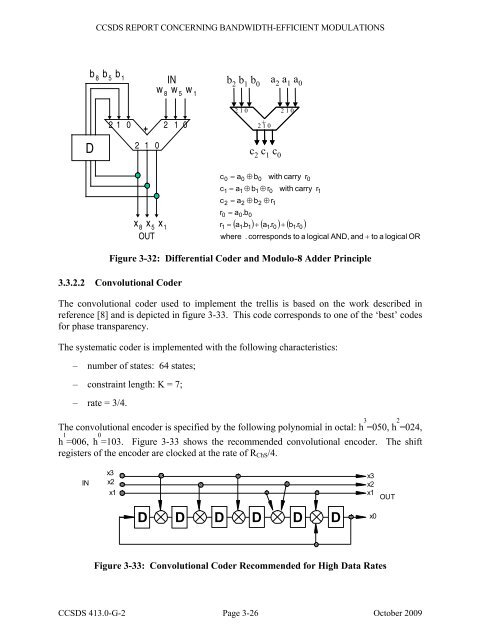413x0g2 - CCSDS
413x0g2 - CCSDS
413x0g2 - CCSDS
You also want an ePaper? Increase the reach of your titles
YUMPU automatically turns print PDFs into web optimized ePapers that Google loves.
<strong>CCSDS</strong> REPORT CONCERNING BANDWIDTH-EFFICIENT MODULATIONSb 8b 5b 1INb 2b 1b 0a 2a 1a 0w 8w 5w 12 1 0 2 1 021 0 + 2 1 02 + 1 0D210c 2c 1c 0x 8x 5x 1OUTcccrr01012= a= a ⊕ b ⊕ r= a= a=10⊕ b⊕ b.bwith carry⊕ rwith carry( a .b ) + ( a .r ) + ( b .r )10201102011 01 0where . corresponds to a logicalr0r1AND, and+ to a logical ORFigure 3-32: Differential Coder and Modulo-8 Adder Principle3.3.2.2 Convolutional CoderThe convolutional coder used to implement the trellis is based on the work described inreference [8] and is depicted in figure 3-33. This code corresponds to one of the ‘best’ codesfor phase transparency.The systematic coder is implemented with the following characteristics:– number of states: 64 states;– constraint length: K = 7;– rate = 3/4.The convolutional encoder is specified by the following polynomial in octal: h 3 =050, h 2 =024,h 1 =006, h 0 =103. Figure 3-33 shows the recommended convolutional encoder. The shiftregisters of the encoder are clocked at the rate of R ChS /4.INx3x2x1x3x2x1OUTDD D D D Dx0Figure 3-33: Convolutional Coder Recommended for High Data Rates<strong>CCSDS</strong> 413.0-G-2 Page 3-26 October 2009
















